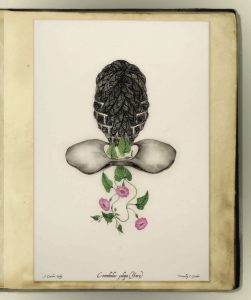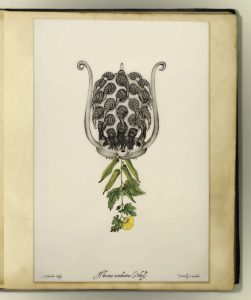Gardner Collective Curatorial Statement
“Yes or no, are these things true? And the sadistic pleasures, the nameless delights that send voluptuous shivers and quivers through Loti’s carcass when he focuses his field glasses on a good massacre of the Annamese? True or not true? And if these things are true, as no one can deny, will it be said, in order to minimize them, that these corpses don’t prove anything? ” – Aime Cesaire in Discourse on Colonialism
Joscelyn Gardner’s “A Collection of Creole Portrait Heads of the Female Sex,” is a piece of art that operates within the Post-colonial critique of the archive according to Michel Foucault’s “Infamous Lives of Men” and a historical lens using Thomas Thistlewood’s journal.
The work is inspired by the Thistlewood diary, a collection of the papers of Thomas Thistlewood. Thistlewood was an 18th century slave owner who immigrated from Britain to  Jamaica to make a fortune as a planter. The diary he left behind is an extensive catalog of his day to day life, written over the course of three decades. His entries ranged from botanical analyses of the flora of Jamaica to accounts of brutality against his slaves. Particularly evident is his catalogue of thousands of acts of rape involving over one hundred female slaves. The diary is an important primary source that informs the dialogue surrounding the history of slavery in Jamaica and the Caribbean more broadly. Gardner’s work engages with the Thistlewood diaries and plays on the colonial association between scientific progress and brutality.
Jamaica to make a fortune as a planter. The diary he left behind is an extensive catalog of his day to day life, written over the course of three decades. His entries ranged from botanical analyses of the flora of Jamaica to accounts of brutality against his slaves. Particularly evident is his catalogue of thousands of acts of rape involving over one hundred female slaves. The diary is an important primary source that informs the dialogue surrounding the history of slavery in Jamaica and the Caribbean more broadly. Gardner’s work engages with the Thistlewood diaries and plays on the colonial association between scientific progress and brutality.
Thistlewood’s diary shows him to be a brutal master and overseer, documenting many forms of torture and punishment. One particularly grotesque punishment that he coined,“Derby’s Dose”, was reserved for runaway slaves. The slave would be flogged, their open wounds would be rubbed with lime juice, salt pickle and pepper, and finally another slave would defecate into the mouth of the runaway slave. The punished slave’s mouth would then be forced shut. This kind of extreme violence was applied liberally and displayed openly to all slaves. Thistlewood used sexual violence as another tool, not only to satisfy his lust, but exert control over the enslaved women’s lives. He would often have sex outdoors for other slaves to see, and most attempts to thwart his actions were severely punished. This kind of violence was common in colonial Jamaica, Thistlewood even remarks that he and some neighbors found that some white newcomers to the area were too violent. Colonial whites believed, given the overwhelming enslaved majority that outnumbered whites by as much as 15 to 1 in western Jamaica, that the only way to ensure dominance was in instilling terror through violence. The relatively small numbers of whites even meant that the typically notable class distinctions of British society gave way to a very strong white pride and fraternity, ever more to the disadvantage of the enslaved.
One method of punishment that Gardner highlights in her work is the use of slave collars as a method of exerting complete control over the present bodies and future progeny of the female slaves. The front cover of her collection describes the purpose of the collars and reads, “Displaying the exotic flowering plants used by enslaved women to destroy their progeny; and the curious iron collars to punish them for these deeds” (Gardner 5) Although some of these collars are highly stylized, they are in fact instruments of torture. Tools of slave torture were key elements in maintaining the racial hierarchy and were used against all kinds of infractions from unproductivity, to runaways, to resisting rape. They surround the women’s necks, limiting mobility or any ability to do basic functions, including eating and sleeping. Making daily life impossible, inflicting pain, constantly ringing like a cow-bell, these collars were a source of humiliation for the wearer.
Gardner also makes use of the particular aesthetic of the journals that colonial botanists would keep in order to emphasize this aspect of the Thistlewood and the colonizers more generally. Thistlewood was educated, known for his large library and was involved in the cataloguing of natural species and other intellectual pursuits. Gardner’s work is based on this historical context, and through her work, engages in a critical dialogue.

Pulling from Jamaica’s colonial roots and enslavement, Gardner chose to use one of the most well known texts of the Caribbean archive by mimicking Thistlewood’s Journal and 17th and 18th century documentain style. In his essay “Lives of Infamous Men” Foucault engages with the archive in a similar fashion as Gardner, illuminating the existences of otherwise “ordinary” personages through their encounters with power. Foucault recognizes that the archive itself is controlled by those in power, causing whatever information available about these “ordinary lives” to be colored by their encounters with power. Similarly Gardner’s “A Collection of Creole Portrait Heads of the Female Sex,” attempts to illuminate the experiences of the women in Thistlewood’s journal, allowing their existence to become more than simply exploits of his desire. Gardner’s work takes the moment at which these women entered Thistlewood’s journal and expands it to include the subsequent possibilities of life for these women after the point of encounter.
Additionally Foucault’s essay points to larger issues of knowledge production, necessitating audiences to question from whom information is received and what is deemed important or worthy of being pulled from the archive. Traditionally, stories of heroism and tragedy of men brought to fame through status are those that are sought. They enter our collective consciousness, becoming parables and models from which to live our lives. However, these “true stories” are either so exaggerated that they seem mythical or myths so vivid that they must be real. Instead of trying to clarify the blurred line between fact and fiction present in the lives of famous men, Foucault, focuses on the lives of infamous men, asserting, “I was determined that these texts always be in a relation or rather in the greatest possible number of relations with reality; not only that they refer to it, but they be operative within it…” (Foucault 160). It is the mundanity of these infamous lives that shows their connection to reality as opposed to the way that famous lives are inflated, thus losing their relationship to reality.
When considering both Foucault’s engagement with the archive and Thistlewood’s documentation of the cruelty shown to his slaves, Gardner’s work becomes especially significant. Gardner’s use of 17th and 18th century documentation formatting allows the subjects of her work the authority that Thistlewood’s accounts strip from them in their portrayal within the archive. Through these historical and critical lenses, Gardner’s work becomes a radical reframing that reveals preservations of the black female body, allowing these women to articulate their own engagement with their brutalization.
References:
(6) “The Autoethnographic Weave of Plantation Poker: The Merkin Stories by Joscelyn Gardner” – YouTube. https://www.youtube.com/watch?v=53bNUARfZmE. Accessed 30 Apr. 2018.
“A Plantation Owners Treasure: The Story of Phibbah.” Unspoken Era, 6 Jan. 2014, https://unspokenera.wordpress.com/2014/01/06/a-plantation-owners-treasure-the-story-of-phibbah/.
Foucalt, Michel, and Robert Hurley. “Power: Lives of Infamous Men.” Essential Works of Foucalt 1954-1984, edited by James Faubion, The New Press, 2003, pp. 157–174.
Kelley, Sean. Review of Burnard, Trevor, Mastery, Tyranny, and Desire: Thomas Thistlewood and His Slaves in the Anglo Jamaican World and Trevor Burnard, Mastery, Tyranny, and Desire: Thomas Thistlewood and His Slaves in the Anglo-Jamaican World. H-Atlantic, H-Review, July 2007. www.h-net.org, http://www.h-net.org/reviews/showrev.php?id=13425.
Vermeulen, Heather V. “Thomas Thistlewood’s Libidinal Linnaean Project: Slavery, Ecology, and Knowledge Production.” Small Axe, vol. 22, no. 1, Apr. 2018, pp. 18–38.
Women in Resistance. http://scholar.library.miami.edu/slaves/womens_resistance/individual_essays/polovna.html. Accessed 30 Apr. 2018.
Cesaire, Aime. Discourse on Colonialism. Monthly Review, 1972.